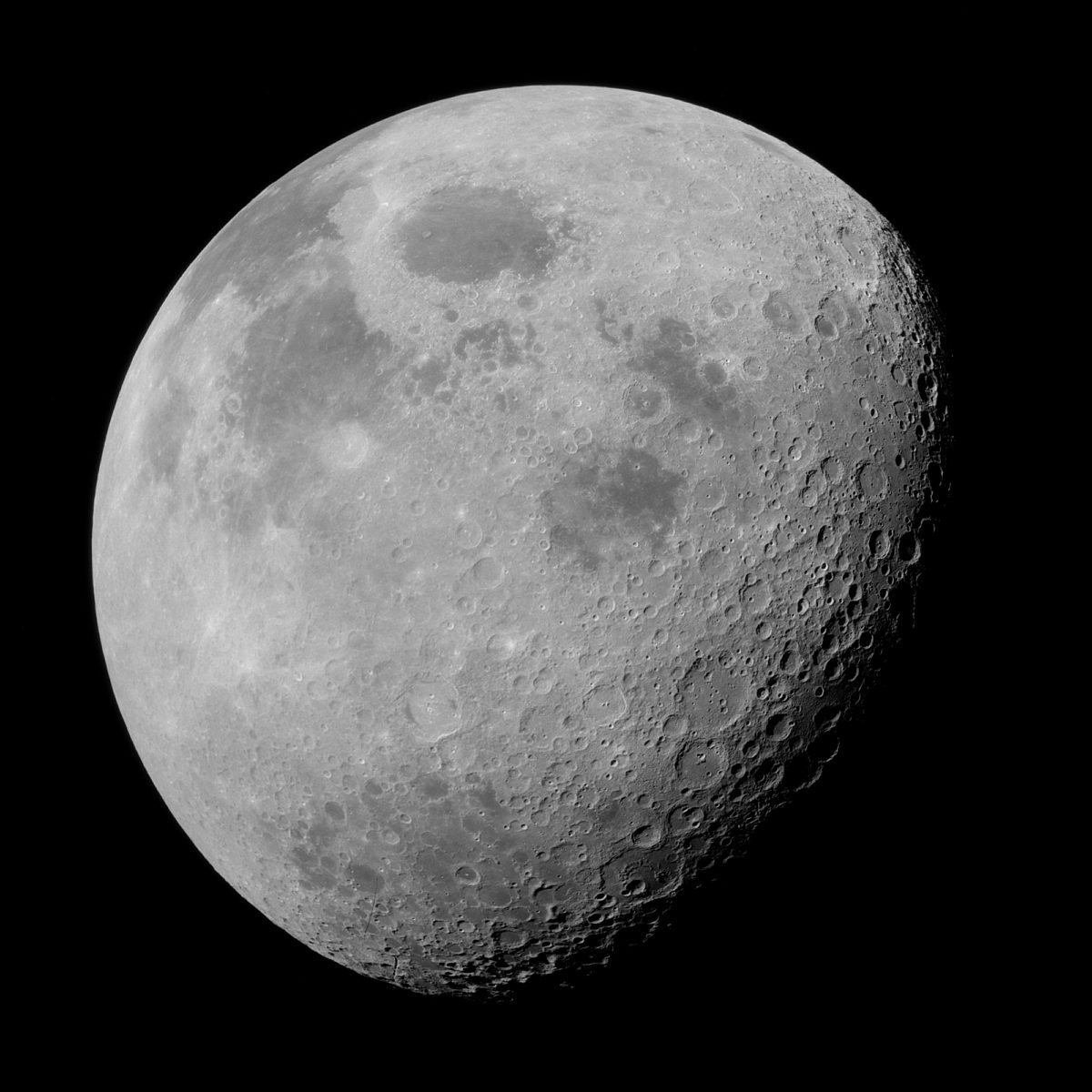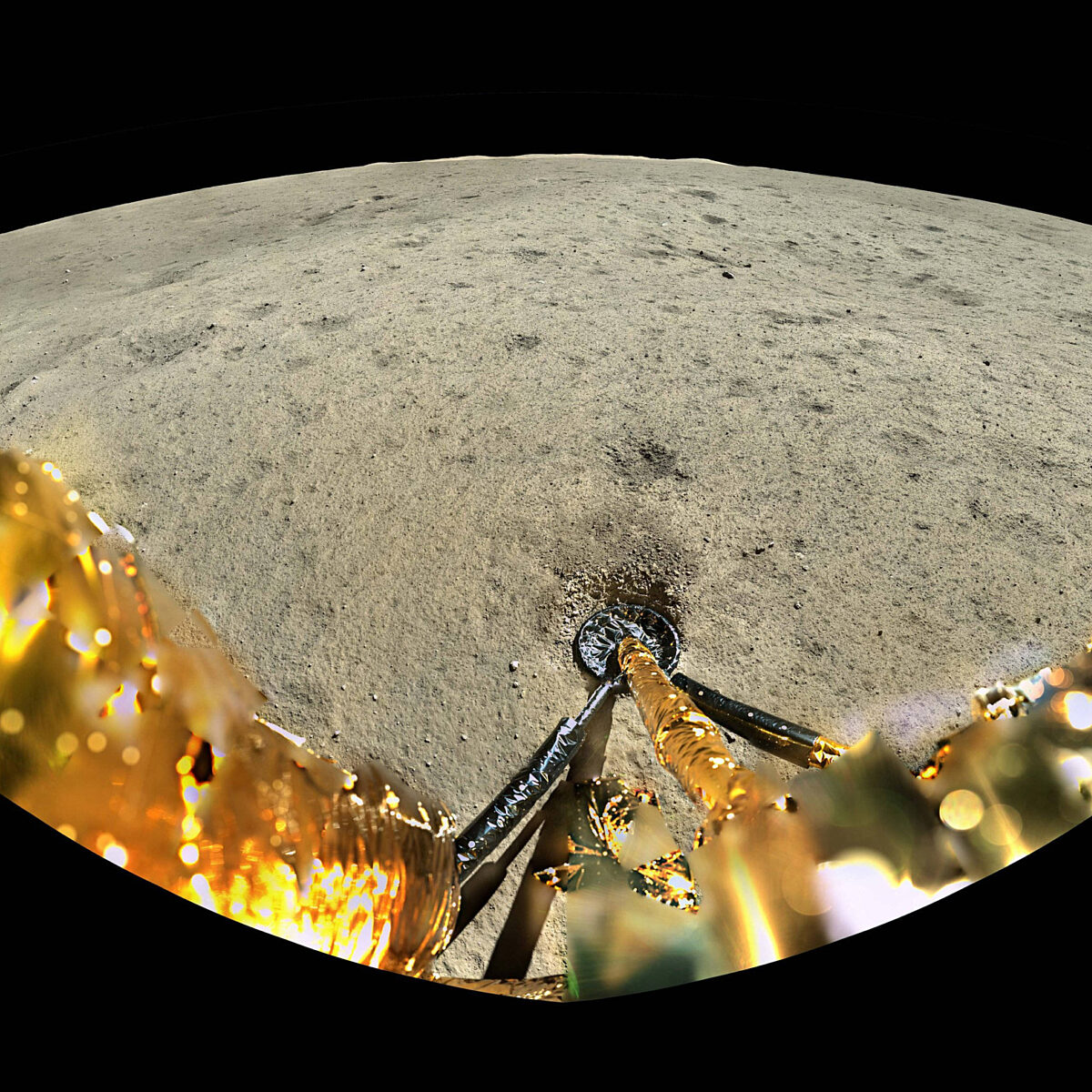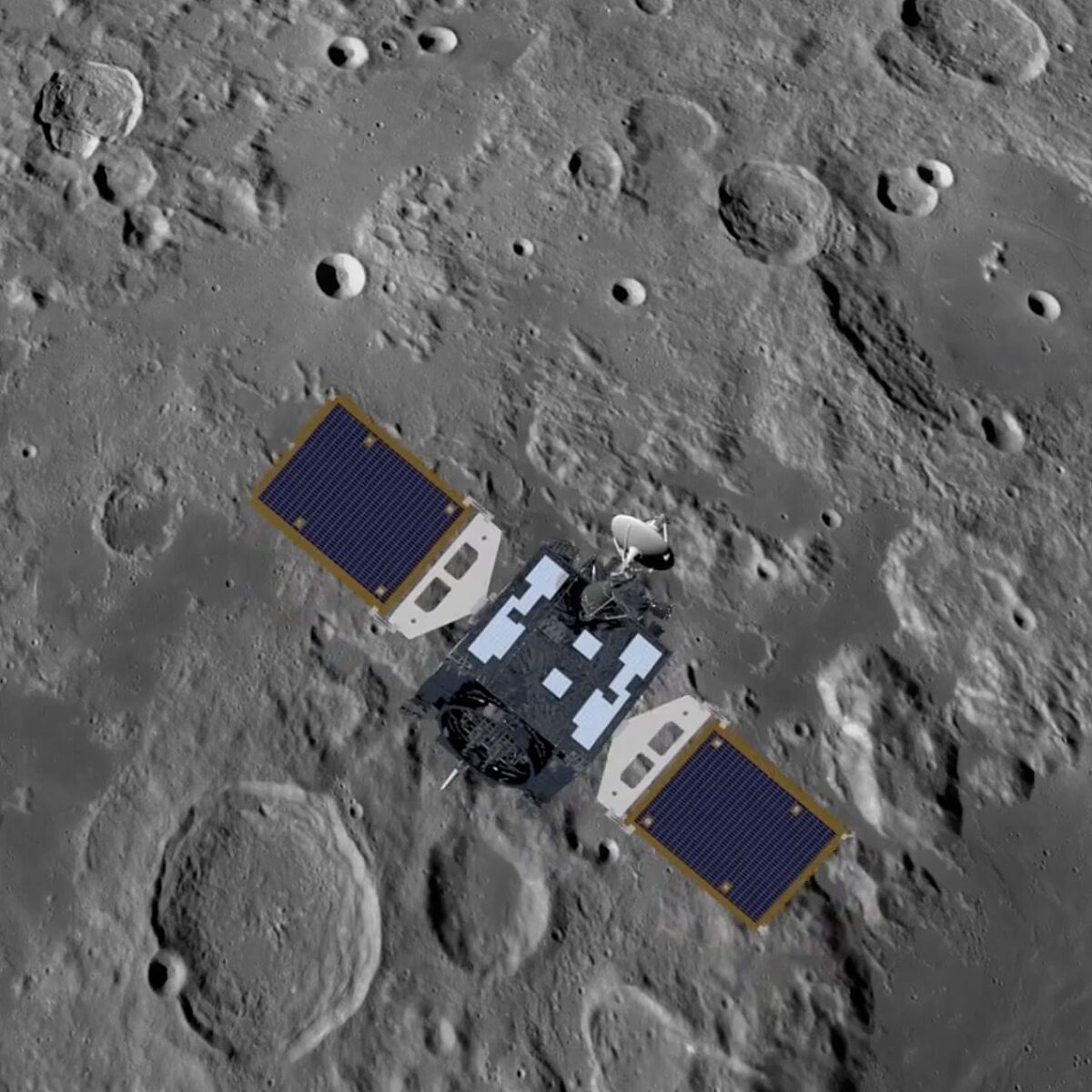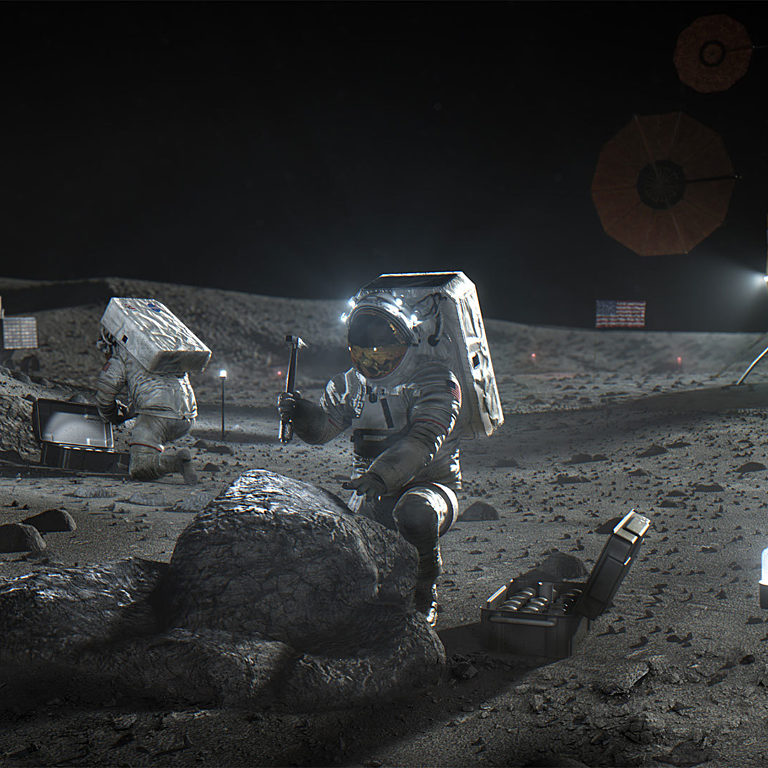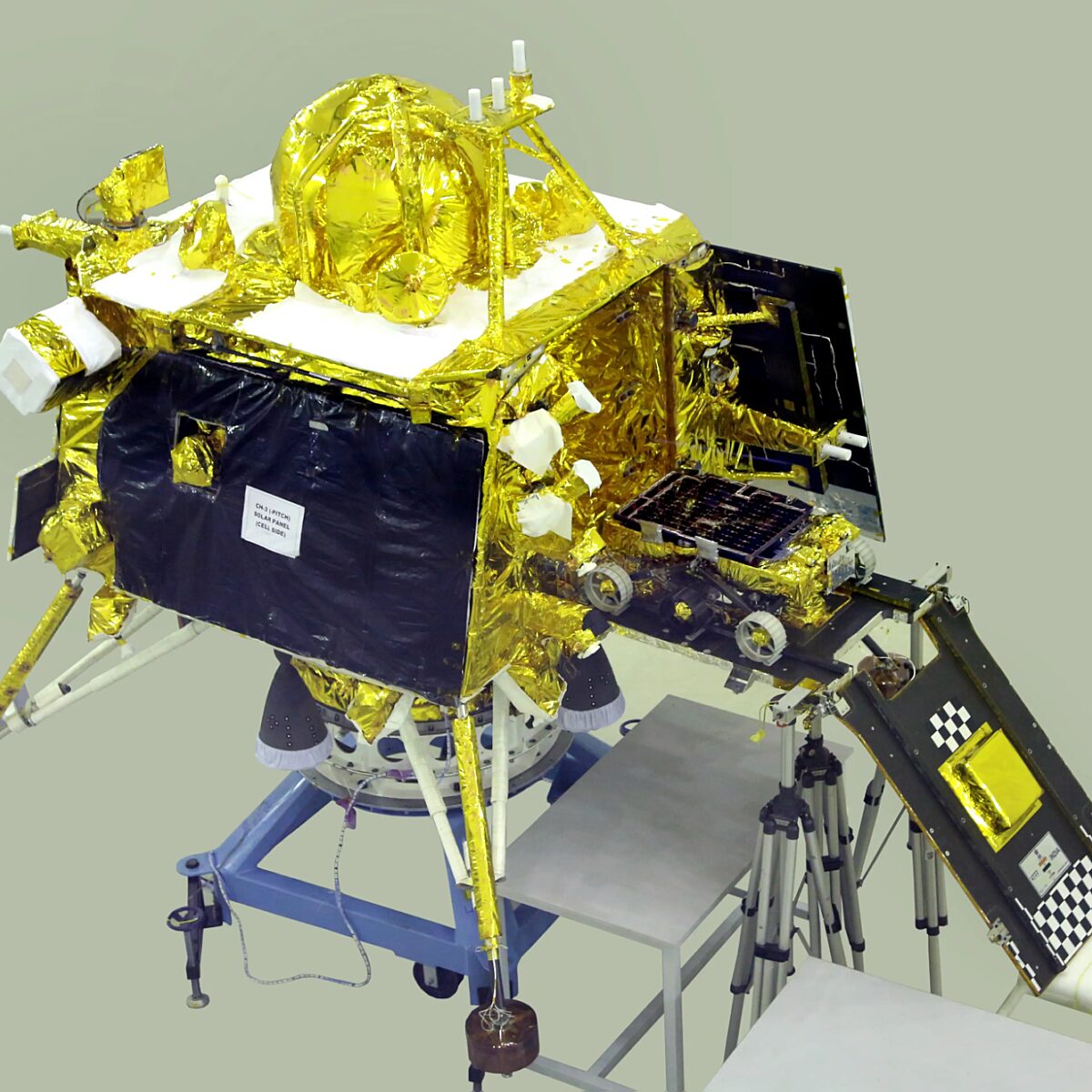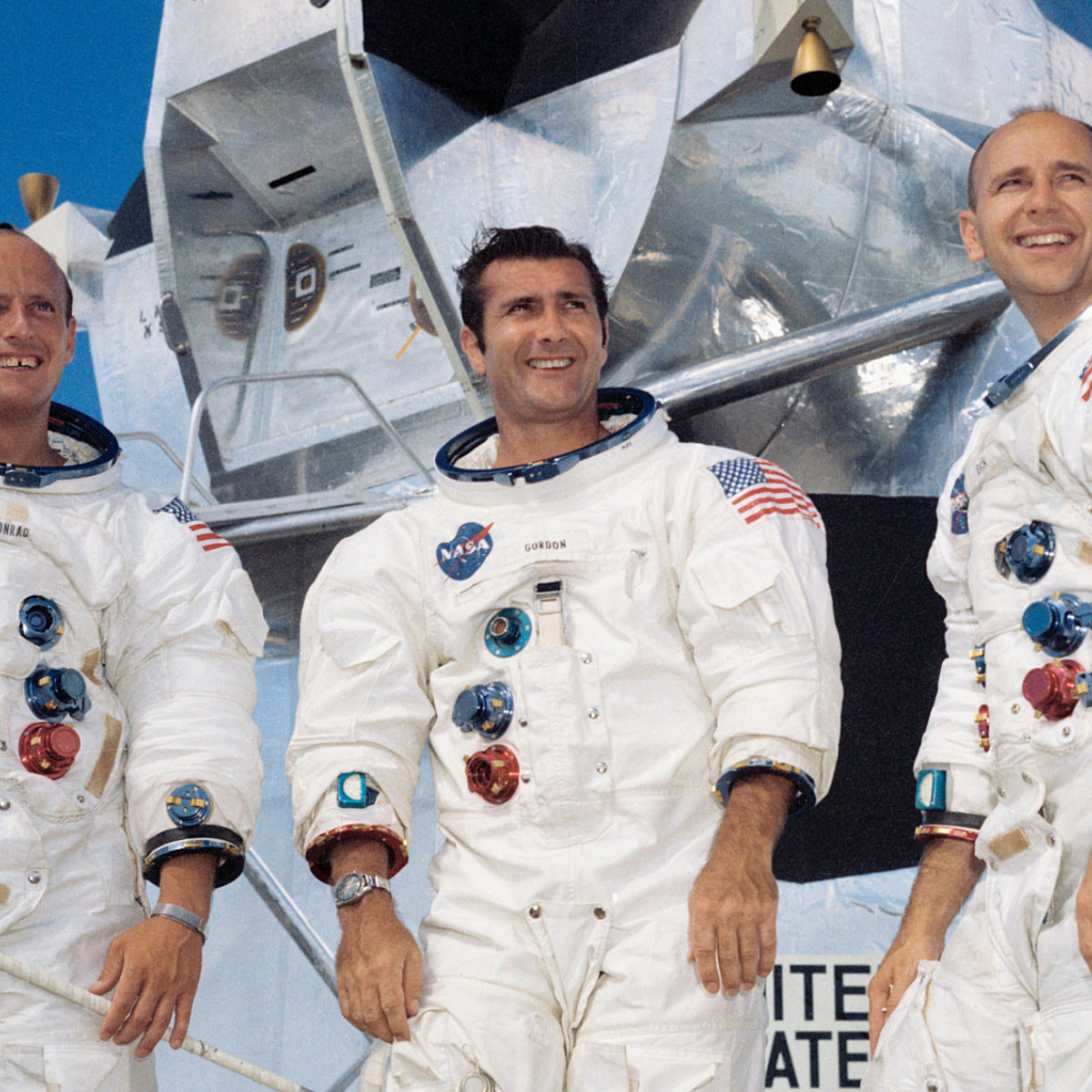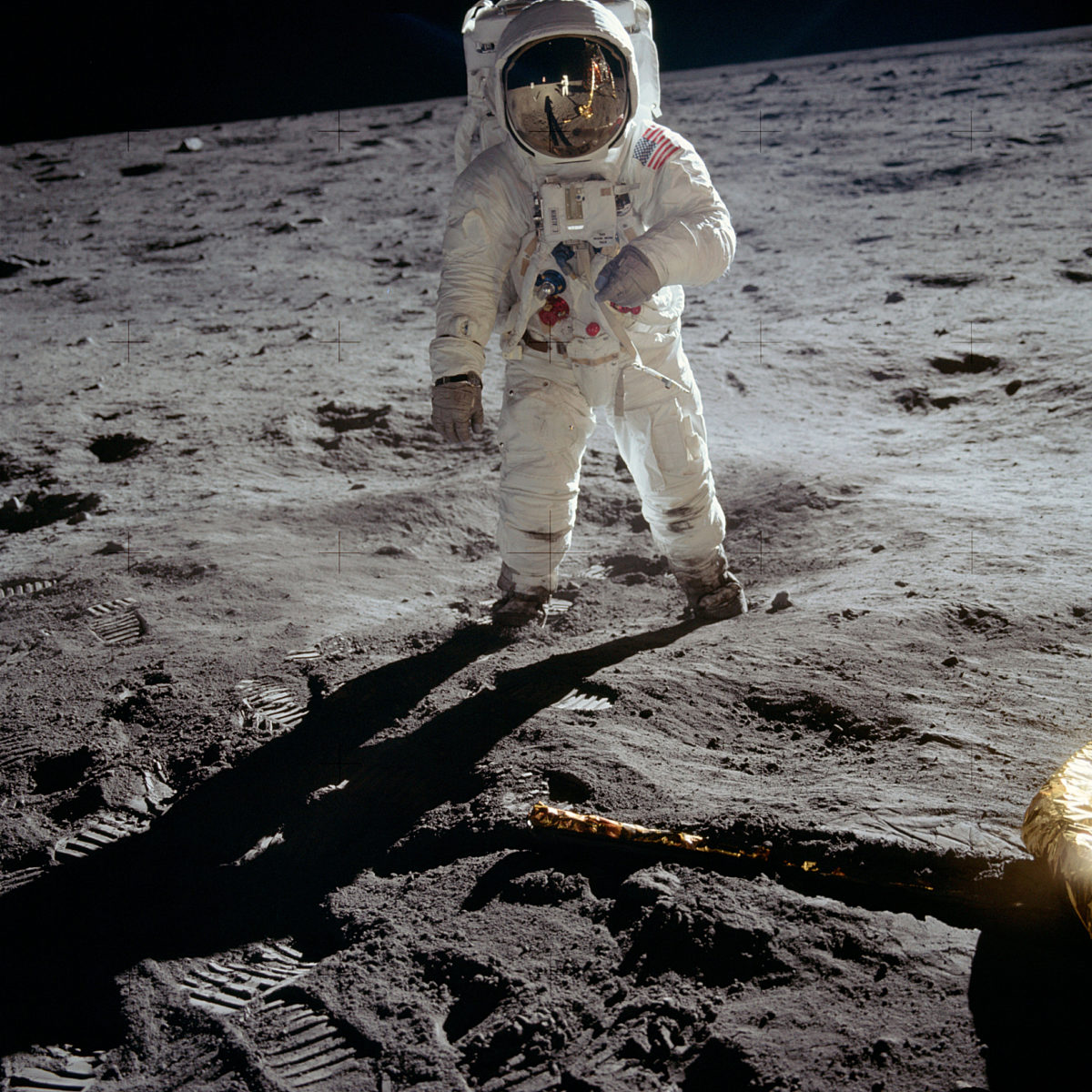Every Mission to the Moon, Ever
It only takes a couple days to send most spacecraft to the Moon, so it's not surprising that humans have sent more missions there than anywhere else. The Moon is also the only celestial body besides Earth where humans have visited.
The Moon, gateway for science and exploration
The Moon is the only world besides Earth ever walked on by humans. By studying it, scientists can learn about Earth’s past and better understand worlds throughout the galaxy.
Active Missions
Chang'e-6, collecting the first lunar farside samples
Chang'e-6 brought back the first samples from the far side of the Moon in June 2024.
Queqiao-2
China's Queqiao-2 lunar communications relay satellite launched on March 19, 2024. Also riding to lunar orbit were Tiandu-1 and Tiandu-2, a pair of experimental lunar communications satellites.
KPLO
Korea's Korea Pathfinder Lunar Orbiter launched in 2022 on a technology demonstration mission aimed at establishing basic lunar exploration capabilities for South Korea. The spacecraft's science payload includes a NASA-provided instrument called ShadowCam.
CAPSTONE
The NASA-funded and Advanced Space-led CAPSTONE spacecraft intends to prove the feasibility of the unique fuel-saving elliptical lunar orbit that the NASA-led international Gateway station will use later this decade.
Chang'e-5
China's Chang’e-5 mission returned Moon samples to Earth and is now in a long-term lunar orbit.
Chandrayaan-2
India's Chandrayaan-2 spacecraft studies the composition of the Moon's surface and searches for signatures of water ice.
Chang'e-4 and Yutu-2
China's Chang'e-4 mission delivered a landing platform and a rover named Yutu-2 to the Moon's farside.
Lunar Reconnaissance Orbiter
NASA's Lunar Reconnaissance Orbiter is a robotic mission mapping the Moon's surface. LRO has collected a treasure trove of data about the Moon, enabling numerous groundbreaking discoveries.
Future missions
Lunar Trailblazer, NASA’s Moon water mapper
Advancing our understanding of water across the Moon for exploration and science.
Artemis
NASA's Artemis program aims to send astronauts to the lunar south pole by 2026, and then on to Mars.
Beresheet2
Israel's Beresheet2 is a privately funded mission scheduled to launch an orbiter and two small landers to the Moon in 2025.
Past missions
DRO-A and DRO-B
A pair of Chinese lunar navigation test satellites were apparently lost during launch on March 13, 2024.
IM-1
Intuitive Machines' Nova-C Odysseus lander landed on the Moon on Feb. 22, 2024.
Peregrine Mission 1
Astrobotic's Peregrine Mission 1 launched on Jan. 8, 2024. It suffered a propellant leak and was unable to attempt a lunar landing. It reentered Earth's atmosphere on Jan. 18, 2024.
SLIM, Japan’s precision lunar lander
JAXA's Smart Lander for Investigating Moon (SLIM) mission landed on Jan. 19, 2024.
Luna 25
Luna 25 was Russia's first Moon landing attempt since 1976. The spacecraft fired its thrusters too long during an orbital maneuver and crashed into the surface on Aug. 19, 2023.
Chandrayaan-3, India's Moon lander and rover
ISRO successfully landed a spacecraft and small rover in the Moon's south polar region.
ispace M1
ispace Japan’s first Moon landing mission launched December 11, 2022 on a SpaceX Falcon 9 rocket, carrying several international payloads including UAE’s Rashid rover. It crashed during its landing attempt in April 2023.
Artemis I
NASA's Space Launch System rocket sent the Orion crew capsule to the Moon and back.
Longjiang-2
China's Chang'e-4 mission on the far side of the Moon requires a relay satellite, Queqiao to stay in contact with Earth. On its way to a parking orbit beyond the Moon, Queqiao dropped off 2 small satellites named Longjiang-1 and Longjiang-2. Longjiang-1 failed to work properly but Longjiang-2 spent more than a year operating in lunar orbit.
Chang'e 3
Launch: December 1, 2013
Orbit insertion: December 6, 2013
Landing: December 14, 2013Chang'e 3 is part of the second phase of the Chinese Lunar Exploration Program, consisting of a robotic lander and China's first lunar rover. The Yutu (Jade Rabbit) rover successfully landed and took images of the lunar surface, but its mobility system failed, leaving the rover unable to move but still alive. One instrument, an ultraviolet telescope, remains functional on Chang'e 3.
Chang'e 2
Launch: October 1, 2010
Orbit insertion: October 6, 2010
Departed lunar orbit: June 8, 2011
Arrived at Sun-Earth L2: August 25, 2011Chang'e 2 was a backup to Chang'e 1. After completing its lunar mapping mission objectives in lunar orbit, Chang'e 2 departed for the Earth-Sun L2 Lagrangian point to test the Chinese tracking and control network. It reached L2 on August 25, 2011, becoming the first object to ever reach the L2 point directly from lunar orbit and traveling further than any Chinese spacecraft. Chang'e 2 then left L2 to perform a flyby of the asteroid 4179 Toutatis on December 12, 2012, the first Chinese asteroid encounter. The probe is now traveling through deep space to further verify China's deep-space tracking and control capabilities.
LADEE
Launch: September 7, 2013
Orbit insertion: October 6, 2013
Lunar impact: April 17, 2014NASA's LADEE (Lunar Atmosphere and Dust Environment Explorer) was designed to orbit around the Moon's equator to study the lunar exosphere and dust. The mission ended when the spacecraft was intentionally crashed into the far side of the Moon.
GRAIL (Ebb and Flow)
Launch: September 10, 2011
Orbit insertion: December 31, 2011 (Ebb), January 1, 2012 (Flow)
Lunar impact: December 17, 2012GRAIL's twin spacecraft flew in tandem orbits around the Moon for several months to measure its gravity field in unprecedented detail. Upon completion of their mission, the spacecraft were intentionally crashed near the moon's north pole.
LCROSS
Launch: June 18, 2009
Lunar impact: October 9, 2009LCROSS (Lunar Crater Observation and Sensing Satellite) launched aboard the same rocket as Lunar Reconnaissance Orbiter. After launch, the LCROSS shepherding spacecraft separated from the upper stage of its launch vehicle, which was directed toward an impact into a permanently shadowed crater, Cabeus, near the lunar south pole. After watching the impact, the shepherding spacecraft also crashed into the lunar pole, an event that was watched by other orbiters and ground-based observatories.
Chandrayaan-1, India’s first Moon mission
The orbiter discovered water on the Moon and kickstarted an ambitious Indian planetary science program.
Chang'e 1
Launched: October 24, 2007
Lunar orbit: November 5, 2007Chang'e 1 was China's first mission beyond Earth orbit. It expanded the capabilities of China's space program, as well as developed a topographic map of the Moon; mapped the composition of the Moon; measured the depth of the lunar soil; and observed the space environment between the Moon and Earth.
Kaguya (SELENE)
Launched: September 14, 2007
Lunar orbit: October 3, 2007
Crashed into Moon: June 10, 2009Kaguya, also known as SELENE (SELenological and ENgineering Explorer), consisted of three spacecraft (a main orbiter and two much smaller satellites, Okina and Ouna), which created the most detailed map of the Moon's gravity field yet acquired. It carried an HDTV camera for obtaining HD movies of Moon and Earth.
SMART-1
Launched: September 27, 2003
Lunar orbit: November 15, 2004
Crashed into Moon: September 3, 2006SMART-1 was powered only by an ion (solar-electric) engine and is the first of the European Space Agency's Small Missions for Advanced Research in Technology, a program to develop a new breed of spacecraft that will demonstrate and test innovative technologies for future deep space missions.
Lunar Prospector
Launched: January 7, 1998
Lunar orbit: January 11, 1998
Crashed into Moon: July 31, 1999Lunar Prospector was designed to go into a low polar orbit around the Moon and search for water ice and other minerals in the dark areas of craters that get very little, if any sunlight. During its 19 month mission, Lunar Prospector completed a map of the Moon's surface composition. On July 31, 1999, mission controllers crashed the spacecraft into a crater near the south pole. Observers from Earth watched for any signs of water vapor that might have been released during the impact, but none was seen.
Clementine
Launched: April 25, 1994
Contact lost: June 1994Clementine was launched by the United States Department of Defense to demonstrate new technologies. The spacecraft flew by Earth twice during the first month of its mission before going into orbit around the Moon. Once in lunar orbit, Clementine began its primary 70-day mapping mission. Then, the spacecraft entered a circumlunar orbit and was to have flown on to an encounter with the asteroid Geographos in July, 1994. However, a malfunctioning thruster depleted all of its maneuvering fuel and the spacecraft was stuck in Earth orbit. It lost power in June 1994, after studying the Van Allen radiation belts.
Hiten / MUSES-A
Launched: January 24, 1990
Lunar orbit: March 19, 1990
Crashed into Moon: April 10, 1990Hiten was launched into a highly elliptical Earth orbit that took it past the Moon 10 times. It released Hagoromo, a small spacecraft that was to go into lunar orbit, but its transmitter failed before it reached the Moon. The Japanese used Hiten to test various technologies for future lunar missions. The spacecraft was intentionally crashed into the moon on April 10, 1993.
Luna 24
Successful lunar sample return (USSR)
Launched: August 9, 1976
Lunar landing: August 18, 1976
Returned to Earth: August 22, 1976Luna 24 softlanded in the Sea of Crises. The spacecraft collected 170 g of lunar dust and rocks and returned to Earth.
Luna 23
Failed lunar sample return (USSR)
Launched: October 28, 1974
Designed as a sample return mission, Luna 23 was damaged during its moon landing on November 6, 1974 and was unable to collect samples. The spacecraft transmitted data for 3 days before falling silent.
Luna 22
Successful lunar orbiter (USSR)
Launched: May 29, 1974
Lunar landing: June 2, 1974During its mission, the spacecraft studied the Moon's magnetic field, gamma ray emissions and gravitational field. The mission ended in November 1975.
Luna 21 / Lunokhod 2
Successful lunar rover (USSR)
Launched: January. 8, 1973
Lunar landing: January 15, 1973The rover first took a panoramic shot of the landing site, before it rolled off of its protective shell and onto the lunar surface. The rover was powered by solar panels and kept warm at night by a radioactive heat source. The mission lasted 4 months, during which it took over 80,000 TV pictures and covered 37 kilometers (22 miles) of lunar terrain.
Apollo 17
Apollo 17, the last crewed Moon landing, sent the first and only geologist to the lunar surface.
Soyuz L3
Failure lunar orbiter and test vehicle (USSR)
Launched: November 23, 1972
Soyuz L3 was designed to test a Soyuz capsule that was to function as the base for a lunar lander. 90 seconds after launch, 6 of the 30 engines shut down, triggering a catastrophic failure of the launch vehicle.
Apollo 16
Astronauts John Young, Charlie Duke and Ken Mattingly launched on April 16, 1972, to explore the lunar highlands of Descartes crater.
Luna 20
Successful lunar sample return (USSR)
Launched: February 14, 1972
Lunar landing: February 21, 1972
Returned to Earth: February 25, 1972Luna 20 soft landed in the Apollonius highlands near the Sea of Fertility. The spacecraft collected samples and then lifted off the next day. The sealed capsule containing 30 grams of lunar rocks and dust landed in the Soviet Union and was retrieved the following day.
Luna 19
Successful lunar orbiter (USSR)
Launched: September 28, 1971
Lunar orbit: October 3, 1971Luna 19 studied the lunar environment, including: lunar radiation levels, mass concentrations, the solar wind, etc.
Luna 18
Failed lunar landing (USSR)
Launched: September 2, 1971
Lunar orbit: September 7, 1971After completing 54 orbits of the Moon, the spacecraft fired its braking thrusters and began its descent to the lunar surface. Communications were lost when the spacecraft impacted with the surface.
Apollo 15
The colossal Apennine mountain range was the backdrop for the 4th crewed landing on the Moon. Astronauts Dave Scott, Jim Irwin, and Al Worden deployed an upgraded suite of hardware and scientific instrumentation, staying longer, roving farther, and doing more science than any Apollo mission up to that point.
Apollo 14
Alan Shepard and Ed Mitchell became the 5th and 6th NASA astronauts to walk on the Moon. It was a triumphant return to lunar exploration after the near-disaster of Apollo 13.
Luna 17 / Lunokhod 1
Successful lunar rover (USSR)
Launched: November 10, 1970
Lunar landing: November 15, 1970Luna 17 soft landed on the Moon in the Sea of Rains. Two ramps extended away from the spacecraft, allowing the Lunokhod rover to roll onto the lunar terrain. Over the course of 11 lunar cycles, the remote controlled rover traveled over 10.5 kilometers (6 miles) and sent back 20,000 television pictures of the lunar landscape. The rover was officially shut down on October 4, 1971.
Zond 8
Successful lunar flyby and back (USSR)
Launched: October 20, 1970
Lunar flyby: October 24, 1970
Earth landing: October 27, 1970Zond 8 flew to the Moon and back, taking color pictures of the Earth and lunar surface along the way. The spacecraft splashed down in the Indian Ocean.
Luna 16
Successful lunar sample return (USSR)
Launched: September 12, 1970
Lunar landing: September 20, 1970
Returned to Earth: September 24, 1970Luna 16 was the first robotic mission to land on the Moon, collect samples of dust and rock, and return those samples to Earth. Luna 16 was also the first spacecraft to land in the lunar darkness. The spacecraft landed in the Sea of Fertility. After collecting dust and rock samples, the spacecraft was launched back into space 26 hours later. It returned to Earth with a soft landing on bringing back 101 grams of Moon rocks.
Apollo 13
Apollo 13 was the 3rd attempt to land humans on the Moon and the 1st to fail. Fifty-six hours into the mission, an explosion forced the crew to abort their Moon landing and take shelter in the Lunar Module. The crew ultimately returned to Earth safely.
Apollo 12
Apollo 12, the second crewed Moon landing, demonstrated a pinpoint landing so future missions could target more ambitious locations.
Luna 1970A and 1970B
These attempted sample return missions by the Soviet Union failed because neither spacecraft achieved Earth orbit.
Cosmos 300 and Cosmos 305
Launched in 1969, these spacecraft reached Earth orbit, but then their respective engines failed and the spacecraft were unable to continue on to the Moon.
Zond 7
Successful lunar flyby and back (USSR)
Launched: August 7 (or 8), 1969
Earth landing: August 14, 1969Zond 7 flew to the Moon and back, taking color pictures of the Earth and lunar surface along the way. The spacecraft soft-landed in Kazakhstan.
Apollo 11
Apollo 11 was the first crewed Moon landing. On 21 July 1969, Neil Armstrong stepped on to the surface and said,
Luna 15
Failed lunar sample return (USSR)
Launched: July 13, 1969
Luna 15 was launched in a veil of secrecy only three days before Apollo 11. The Soviets did not reveal the target or mission of Luna 15 causing some concern on the part of the United States. Would Luna 15's mission interfere with Apollo 11? Where would it land? Would there be communication interference? Just two hours before the liftoff of Apollo 11, Luna 15 began its descent to the surface in the Sea of Crisis. The spacecraft crashed landed on the lunar surface. The Soviets issued a statement claiming the research part of the mission was complete, but there had been hints that Luna 15 was intended to be sample return mission. No samples were returned.
Apollo 10
Apollo 10 successfully demonstrated all major objectives of the upcoming Apollo 11 mission except the landing and moonwalk itself.
Luna 1969B and Luna 1969C
Launched in 1969, these sample return mission attempts failed because the rockets carrying the spacecraft exploded shortly after launch.
Apollo 9
Apollo 9 was the first flight test of the lunar module, the spider-like lander that would carry astronauts to the surface of the Moon.
Zond L1S-1 and LIS-2
These test launches of the powerful Soviet N-1 rocket in 1969 for future crewed missions failed due to the rockets exploding shortly after liftoff.
Luna 1969A
Failed lunar rover (USSR)
Launched: February 19, 1969
The spacecraft's rocket exploded shortly after launch.
Zond 1967A, 1967B, 1968A and 1969A
These Soviet missions intended to test their crewed lunar capsules before putting humans in them were unsuccessful due to rocket launch failures.
Apollo 8
Apollo 8 was the first crewed flight around the Moon.
Zond 6
Successful lunar flyby and back (USSR)
Launched: November 10, 1968
Zond 6 was seen by the western powers as being the Soviet Union's final test before launching cosmonauts to the Moon. Once the spacecraft left Earth orbit, it took 2 days to reach the Moon. There, it took pictures as it swung close to the lunar surface. Zond 6 then returned to Earth. Instead of splashing down in the Indian Ocean, like the previous Zond 5 mission, controllers programmed the spacecraft to bounce off the atmosphere and redirected the capsule to parachute to a landing within Soviet territory.
Zond 5
Successful lunar flyby and back (USSR)
Launched: September 15, 1968
Zond 5 left Earth orbit, flew around the Moon and returned to our planet, splashing down in the Indian Ocean. The spacecraft was recovered and taken back to the USSR for study. Not much information was released about this mission, but many believed Zond 5 was one of the last steps before the Soviet Union landed cosmonauts on the Moon.
Luna 14
Successful lunar orbiter (USSR)
Launched: April 7, 1968
Lunar orbit: April 10, 1968The spacecraft took images of the Moon and studied the lunar gravitational field.
Surveyor 7
Successful lunar lander (USA)
Launched: Jan. 7, 1968
Lunar landing: January 9, 1968Surveyor 7 landed in the lunar highlands near the crater Tycho. Scientists used the scoop on the spacecraft to "weigh" lunar rocks, based on how much current was needed to lift each rock. Images sent back from the spacecraft indicated, for the first time, that some of the lunar rocks had been molten at some time in their history. The mission was successfully completed on February 21, 1968.
Surveyor 6
Successful lunar lander (USA)
Launched: November 7, 1967
Lunar landing: November 9, 1967Surveyor 6 touched down in Sinus Medii. Once on the surface, the spacecraft took a series of pictures and soil samples. Then, on November 17, controllers ordered the spacecraft's engines to fire, lifting Surveyor 6 off the lunar surface 3 meters (10 feet) and setting it down again a few feet from the original landing site. The spacecraft then took pictures of the former landing site, checking for evidence of a crater created by the rocket's exhaust. No crater was found, indicating that the Moon's surface was solid. Last contact with the spacecraft was December 14, 1967.
Surveyor 5
Successful lunar lander (USA)
Launched: September 8, 1967
Lunar landing: September 10, 1967Despite a serious helium leak that occurred during its trip to the Moon, controllers were able to bring Surveyor 5 to a success touchdown. Once on the ground, controllers ordered the spacecraft to fire its engine to test the composition of the soil beneath the lander. The test firing blew away a few clumps of soil, but did not create a crater. The final transmission from the spacecraft was received on December 17, 1967.
Lunar Orbiter 5
Successful lunar orbiter (USA)
Launched: August 1, 1967
Lunar orbit: August 5, 1967Upon completion of this mission, over 99% of the Moon's surface had been mapped (with data from all previous missions combined). The mission ended when controllers sent the spacecraft crashing to the lunar surface on January 31, 1968.
Surveyor 4
Failed lunar lander (USA)
Launched: July 14, 1967
Controllers lost contact with Surveyor 4 just two and a half minutes before it was to touch down in Sinus Medii.
Lunar Orbiter 4
Successful lunar orbiter (USA)
Launched: May 4, 1967
Lunar orbit: May 8, 1967The spacecraft was the first to take pictures of the Moon's south pole. It took images from orbit for eight months before controllers sent the spacecraft crashing to the lunar surface. Crashing the spacecraft into the Moon kept an area around the Moon clear of debris that might compromise the upcoming crewed missions.
Surveyor 3
Successful lunar lander (USA)
Launched: April 17, 1967
Lunar landing: April 20, 1967As Surveyor 3 came in for a soft landing on the Moon one of its thrusters didn't turn off at the proper time and the spacecraft bounced a couple of times before it came to rest in the Ocean of Storms. Onboard the spacecraft, a scoop was used to collect soil samples, and a camera took over 6,300 images.
Lunar Orbiter 3
Successful lunar orbiter (USA)
Launched: February 4, 1967
Lunar orbit: February 8, 1967The spacecraft's orbit was altered several times during the mission to give controllers on Earth more experience with communications during lunar orbit. Lunar Orbiter 3 was able to photograph Surveyor 2 on the surface. The mission ended on October 9, 1967, when controllers deliberately crashed the spacecraft into the Moon.
Luna 13
Successful lunar lander (USSR)
Launched: December 21, 1966
Lunar landing: December 24, 1966Luna 13 bounced to a landing on the lunar surface coming to a rest in the Oceans of Storms between the craters Selencus and Craft. The lander collected soil samples and conducted experiments to determine the soil density and radioactivity. The mission ended on December 30, 1966, when the spacecraft's supplies were depleted.
Lunar Orbiter 2
Successful lunar orbiter (USA)
Launched: November 6, 1966
Lunar orbit: November 6, 1966
Lunar impact: October 11, 1967Lunar Orbiter 2 went into lunar orbit and took over 800 pictures during its mission, including an oblique view of the crater Copernicus that was voted one of the best images of the century by the press. The spacecraft was deliberately sent crashing into the lunar surface on October 11, 1967, bringing to an end the successful mission.
Luna 12
Successful lunar orbiter (USSR)
Launched: October 22, 1966
Lunar orbit: October 25, 1966The primary mission of the spacecraft was to photograph the lunar surface and it did, taking 1,100 pictures including images of the Sea of Rains and the area surrounding the crater Aristarchus. The mission was terminated on January 19, 1967 after 602 orbits.
Surveyor 2
Failed lunar lander (USA)
Launched: September 20, 1966
Lunar impact: September 22, 1966Just before touchdown, one of the thrusters on the spacecraft malfunctioned during a mid course correction and Surveyor 2 tumbled out of control. It crashed into the moon, southeast of the crater Copernicus.
Luna 11
Successful lunar orbiter (USSR)
Launched: August 24, 1966
Lunar orbit: August 27, 1966The spacecraft, designed to test new technology, completed 277 orbits before its mission was terminated on October 1, 1966.
Lunar Orbiter 1
Successful lunar orbiter (USA)
Launched: August 10, 1966
The spacecraft sent back high-quality images (by television) of over two million square miles of lunar surface, including the first detailed images of potential Apollo landing sites. After circling the Moon 527 times in 77 days, engineers on Earth deliberately crashed the spacecraft onto the Moon's surface, so that it wouldn't interfere with the upcoming crewed missions.
Surveyor 1
Successful lunar lander (USA)
Launched: May 30, 1966
Surveyor 1 was the first spacecraft from the United States to perform a controlled landing on the surface of the Moon. Once on the surface, Surveyor 1 took over 11,100 images of the lunar landscape during its six-week mission.
Luna 10
Successful lunar orbiter (USSR)
Launched: March 31, 1966
Lunar arrival: April 2, 1966Luna 10 arrived at the Moon becoming the first spacecraft to successfully go into orbit around another celestial body. While in orbit, Luna 10 studied radiation levels, cosmic ray intensities, and took readings of the Moon's weak magnetic field. The spacecraft successfully transmitted data for two months, circling the Moon 460 times before its mission came to an end on May 30, 1966.
Cosmos 111
Failed moon flyby (USSR)
Launched: March 1, 1966
The spacecraft was unable to achieve a lunar trajectory. It re-entered Earth's atmosphere on March 3, 1966.
Luna 9
Successful lunar lander (USSR)
Launched: January 31, 1966
Lunar landing: February 3, 1966Luna 9 became the first spacecraft to make a controlled landing onto the surface of another celestial body. Scientists believe Luna 9 landed on the sloping floor of a shallow crater. Over the next two days, the spacecraft sent back three panoramas of the lunar landscape. During the second and third transmission, the spacecraft evidently shifted or settled a few centimeters, because the third batch of images were taken from a slightly different angle. The different angle allowed scientists to construct a stereoscopic view of the landing site and determine the distances to various rocks and depressions. The last communication with the spacecraft was on Feb. 5, 1966.
Luna 8
Failed lunar lander (USSR)
Launched: December 3, 1965
Lunar impact: December 6, 1965Luna 8 made it to the Moon, but its retro rockets fired too late and the spacecraft crash-landed in the Ocean of Storms, east of the crater Galilei.
Luna 7
Failed lunar lander (USSR)
Launched: October 4, 1965
Lunar impact: October 7, 1965Luna 7 made it to the Moon, but its retro rockets switched on too soon. The spacecraft crash-landed in the Ocean of Storms, west of the crater Kepler.
Zond 3
Successful lunar flyby (USSR)
Launched: July 18, 1965
Zond 3 took 25 images as it flew by the far side of the Moon, then transmitted the images back to Earth nine days later. After passing the Moon, the spacecraft went into a solar orbit.
Luna 6
Failed lunar lander (USSR)
Launched: June 8, 1965
On its way to the Moon, a rocket failed to turn off after a trajectory correction maneuver. As a result, Luna 8 missed the Moon and went into a solar orbit.
Luna 5
Failed lunar lander (USSR)
Launched: May 9, 1965
Lunar Impact: May 12, 1965This mission was the first-ever attempt to soft-land a spacecraft on the Moon. Luna 5's retro-rockets failed to fire and the spacecraft crash-landed near the Sea of Clouds.
Ranger 9
Successful lunar impactor (USA)
Launched: March 21, 1965
Ranger 9 took over 5,800 images of the Moon's surface before it crash-landed in the crater Alphonsus. Network television broadcasted images from the spacecraft as they were received—live from the Moon!
In all, the Ranger missions sent over 15,000 high-resolution photographs to Earth. It’s from this data that NASA selected safe landing regions for the Apollo missions. The robotic Ranger missions were thus critical for NASA to safely land humans on the Moon in 1969.
Ranger 8
Successful lunar impactor (USA)
Launched: February 17, 1965
Lunar impact: February 20, 1965.Ranger 8 took over 7,100 high quality images of the Moon's surface before it crash-landed in the vast lava plain called Sea of Tranquility.
Ranger 7
Successful lunar impactor (USA)
Launched: July 28, 1964
Lunar impact: July 31, 1964Ranger 7 sent back the first up-close images of the Moon's surface before it crash-landed in the vast lava plain called Sea of Clouds. Over 4,300 images were sent back.
Ranger 6
Failed lunar impactor (USA)
Launched: January 30, 1964
Lunar impact: February 2, 1964.Ranger 6 was designed to take a series of images as it approached the Moon, right up to the point where it crashed into its surface. Unfortunately, the spacecraft's cameras failed and no pictures were returned. Ranger 6 crash-landed in the Sea of Tranquility.
Luna 4
Failed lunar orbiter (USSR)
Launched: April 2, 1963
Contact with Luna 4 was lost after it past within 9,300 kilometers (5,780 miles) of the Moon.
Sputnik 25
Failed lunar lander (USSR)
Launched: January 4, 1963
After a successful launch, the spacecraft failed to transfer to a lunar trajectory and burnt up as it re-entered Earth's atmosphere.
Ranger 5
Failed lunar Lander (USA)
Launched: October 18, 1962
A solar cell onboard Ranger 5 failed shortly after launch. Without power, engineers on the ground were unable to control the spacecraft and Ranger 5 missed the Moon by 720 kilometers (450 miles).
Ranger 4
Failed lunar lander (USA)
Launched: April 23, 1962
Lunar impact: April 26, 1962After a successful launch, a failure of some sort onboard Ranger 4 made communication with the spacecraft impossible. Engineers were able to track the spacecraft until it crashed on the far side of the Moon, but were unable to collect any data.
Ranger 3
Failed lunar lander (USA)
Launched: January. 26, 1962
Designed to take close-up images of the Moon before impacting with its surface, Ranger 3 missed the Moon and ended up in a solar orbit.
Ranger 1 and Ranger 2
Launched: August 23, 1961
Launch in 1961, NASA's Ranger 1 and Ranger 2 spacecraft were designed to test the feasibility of going into a parking orbit around Earth before heading out to the Moon. A parking orbit would give engineers time to calculate a much more accurate trajectory for the spacecraft to follow to the Moon. Ranger 1 and 2 both made it into low Earth orbit but failed to re-ignite their engines afterward, which ultimately led them to enter and burn up in Earth's atmosphere.
Pioneer P-3
Failed lunar flyby (USA)
Launched: November 26, 1959
The protective cover that surrounded the spacecraft while it was attached to the rocket broke away after only 45 seconds in flight. As a result, the spacecraft failed to reach orbit and crashed back to Earth.
Luna 3
Successful lunar flyby (USSR)
Launched: October 4, 1959
Luna 3 was the first spacecraft to take pictures of the far side of the Moon. It is uncertain how many pictures the spacecraft returned, but three images were released to the public, as well as a composite image of the full disc of the Moon's far side, which was made up of several frames. As a result of these pictures, the Russians were the first to name features on the far side of the Moon. Luna 3's trajectory took the spacecraft from Earth, around the Moon and back, where it reentered the Earth's atmosphere on April 20, 1960.
Luna 2
Successful lunar impactor (USSR)
Launched: September 12, 1959
Lunar impact: September 14, 1959Luna 2 was the first spacecraft to land on another celestial body. |The spacecraft impacted on the Moon's surface just east of the Sea of Serenity near the craters Aristides, Archimedes, and Autolycus. The spacecraft did not detect a magnetic field around the Moon.
Pioneer 4
Successful lunar flyby (USA)
Launched: March 3, 1959
Pioneer 4 passed within 60,000 kilometers (37,300 miles) of the Moon, returned data on lunar radiation levels, then entered a solar orbit.
Luna 1
Failed lunar impactor (USSR)
Launched: January 2, 1959
The spacecraft missed the Moon and went into a solar orbit. However, the spacecraft did provide some scientific data when it released a sodium vapor cloud 70,000 miles from Earth that allowed scientists to study interplanetary gases.
Pioneer 3
Failed lunar flyby (USA)
Launched: December 6, 1958
The rocket's first stage shut off early, causing the spacecraft to crash.
Pioneer 2
Failed lunar orbiter (USA)
Launched: November 8, 1958
Just after launch, the second stage of the rocket failed to ignite. As a result, the spacecraft did not achieve orbit and fell back to Earth.
Pioneer 1
Failed lunar orbiter (USA)
Launch: October 11, 1958
Just after launch, the rocket's second and third stage failed to separate evenly. As a result, the spacecraft was unable to achieve a lunar trajectory. However, Pioneer 1 did manage to returned data on the Van Allen Belt and micrometeorite impacts before re-entering Earth's atmosphere on Oct. 12, 1958.
Luna 1958A, Luna 1958B, Luna 1958C, Luna 1959A, Luna 1960A, Luna 1960B and Luna 1963B
All of these Soviet lunar impactor missions, launched in the years they are named after, were unsuccessful due to their rockets failing at various stages after launch.
Pioneer 0
Failed lunar orbiter (USA)
Launch: August 17, 1958
The first attempt by the United States to fly to the Moon ended just 77 seconds after liftoff when the rocket's first stage exploded.


 Explore Worlds
Explore Worlds Find Life
Find Life Defend Earth
Defend Earth


